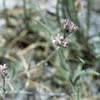USDA Forest Service Celebrating Wildflowers
|
|
|
Jeffrey Pine Shrubland
The Jeffrey pine shrubland is the mesic end of a continuum whose other, more xeric end is the Jeffrey pine savanna. Whittaker describes this continuum as a "two-phase character of essentially closed shrub cover alternating with shrub-less openings with grasses and other herbs." As grass cover falls below 50% in more moist sites, the shrubby openings form the continuous phase with discontinuous grassy patches, until a shrubland is present. Peridotite and serpentinized peridotite comprise the primary soils in Jeffrey pine shrublands found just below flattened or broad ridgetops that support Jeffrey pine savanna communities. Soils are deeper and are composed of material that has eroded from higher elevations and ridgetops over time. Jeffrey pine shrublands occur between 1,400 and 5,000 feet. Stunted Jeffrey pines (Pinus jeffreyi) and incense cedars (Calocedrus decurrens) characterize the overstory, which is interspersed throughout with discrete shrub, grass, and herbaceous (forb) plant communities. This shrubland community exists as a vegetative mosaic due to localized differences in soil moisture, soil depth, and degree of peridotite serpentinization. It is composed of drought-tolerant, woody, or leathery species, such as buckbrush (Ceanothus cuneatus), California coffeeberry (Rhamnus californica), hoary manzanita (Arctostaphylos canescens), pinemat manzanita (Arctostaphylos nevadensis), leatheroak (Quercus durata), birchleaf mountain-mahogany (Cercocarpus betuloides), and dwarf silktassel (Garrya buxifolia). Nested within the shrublands are open patches of grasses such as Idaho fescue (Festuca idahoensis), squirreltail (Elymus elymoides), and California melicgrass (Melica californica). Herbaceous openings often concentrate patches of Jeffrey pine and incense cedar and carry a diversity of forbs including Blue Mountain buckwheat (Eriogonum strictum), Yolla Bolly bedstraw (Galium ambiguum), serpentine phacelia (Phacelia corymbosa), Green’s blue-eyed Mary (Collinsia greenei), flame ragwort (Senecio greenei), serpentine milkweed (Asclepias solanoana) and sicklefruit jewelflower (Streptanthus drepanoides). Many of these forbs are found in herbaceous openings of the Jeffrey pine savanna community as well. The Jeffrey pine and incense cedar overstory, generally from 20% to upwards of 30%, can vary from either species being dominant to the two being codominant, but total canopy cover is always greater than that seen in the Jeffrey pine savanna community. Jeffrey pines in this community can reach 300 to 400 years of age and incense cedars typically develop a contorted appearance with age. The canopy cover of the shrub layer can approach 80% (Whittaker 1960). Grassy openings appear as a pebble and rock gardens with tufts of Idaho fescue and scattered herbs. In the Jeffrey pine shrubland one may encounter rare species including Peanut sandwort (Minuartia rosei), serpentine goldenbush (Ericameria ophitidis), Trinity phacelia (Phacelia dalesiana), Tedoc Mountain linanthus (Leptosiphon nuttallii ssp. howellii), and threadleaf beardtongue (Penstemon filiformis).
Photo Gallery
Our thanks to CalPhotos and its many contributors for many of the pictures in this photo gallery. |
|
| NOTE: PDF format links require the Adobe Acrobat Reader to view. | |
| top | Disclaimers | FOIA | Privacy Policy | Quality of Information | Photo Credits & Use |
Location: http://www.fs.fed.us/wildflowers/communities/serpentines/communities/jeffreypine_shrubland.shtml
Last modified: Wednesday, 03-Dec-2008 13:54:23 EST
















